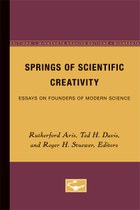Similar titles: The Moving Image
-
 Rhetoric
Renato Barilli
1989 Spring
Rhetoric
Renato Barilli
1989 Spring
- A concise history of rhetoric from ancient Greece to contemporary media technologies.
-
 The Future of an Illusion
Film, Feminism, and Psychoanalysis
Constance Penley
1989 Spring
The Future of an Illusion
Film, Feminism, and Psychoanalysis
Constance Penley
1989 Spring
- Analyzes the primary movements that have shaped the field of feminist film theory. Essential to anyone studying the sexual politics of representation.
-
 Science as Power
Discourse and Ideology in Modern Society
Stanley Aronowitz
1988 Fall
Science as Power
Discourse and Ideology in Modern Society
Stanley Aronowitz
1988 Fall
- “Sets the stage for a new social theory of science. Aronowitz does not merely envision a new account of science; he argues for a critical, reflexive alternative to modern science, one that is not based on the domination of humans and nature.” --Contemporary Sociology
-
 Quality Maintenance in Stored Grains and Seeds
Clyde M. Christensen and Richard A. Meronuck
1986 Fall
Quality Maintenance in Stored Grains and Seeds
Clyde M. Christensen and Richard A. Meronuck
1986 Fall
-
 The Scientific Marx
Daniel Little
1986 Fall
The Scientific Marx
Daniel Little
1986 Fall
-
 The Colonial Harem
Malek Alloula
1986 Spring
The Colonial Harem
Malek Alloula
1986 Spring
- A collection of picture postcards of Algerian women exploited by the French, this “album” illustrates a powerful analysis of the distorting, denigrating effects of their presence on Algerian Society.
-
 Postmodernism and Politics
Jonathan Arac, Editor
1986 Spring
Postmodernism and Politics
Jonathan Arac, Editor
1986 Spring
- Eight essays on postmodernism with a focus on intellectual, artistic and social concerns.
-
 Cloning
Nuclear Transplantation in Amphibia
Robert Gilmore McKinnell
None None
Cloning
Nuclear Transplantation in Amphibia
Robert Gilmore McKinnell
None None
-
 Noise
The Political Economy of Music
Jacques Attali
1984 Fall
Noise
The Political Economy of Music
Jacques Attali
1984 Fall
- Argues that music does not reflect society; it foreshadows new social formations.
-
 Mentality and Machines
Keith Gunderson
1985 Spring
Mentality and Machines
Keith Gunderson
1985 Spring
-
 The Limits of Scientific Reasoning
David Faust
1984 Fall
The Limits of Scientific Reasoning
David Faust
1984 Fall
- Draws upon the findings of cognitive psychology to show that human judgment is far more limited than we have tended to believe, and that all individuals, scientists included, have a surprisingly restricted capacity to interpret complex information.
-
 The Postmodern Condition
A Report on Knowledge
Jean-François Lyotard
1984 Spring
The Postmodern Condition
A Report on Knowledge
Jean-François Lyotard
1984 Spring
- This founding essay of the postmodern movement argues that knowledge-science, technology, and the arts-has undergone a change of status since the 19th century and especially since the late 1950s.
-
 Testing Scientific Theories
John Earman, Editor
1984 Spring
Testing Scientific Theories
John Earman, Editor
1984 Spring
-
 Springs of Scientific Creativity
Essays on Founders of Modern Science
claire Aris, H. Ted Davis and Roger H. Stuewer, Editors
None None
Springs of Scientific Creativity
Essays on Founders of Modern Science
claire Aris, H. Ted Davis and Roger H. Stuewer, Editors
None None
-
 The Cineaste Interviews
On the Art and Politics of the Cinema
Dan Georgakas and Lenny Rubenstein, Editors
None None
The Cineaste Interviews
On the Art and Politics of the Cinema
Dan Georgakas and Lenny Rubenstein, Editors
None None